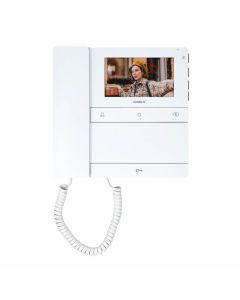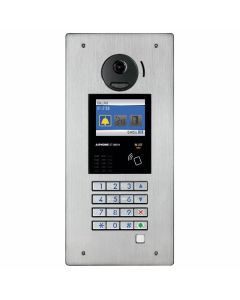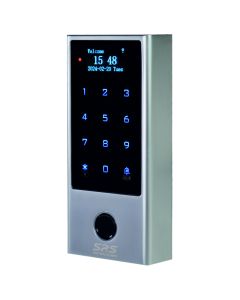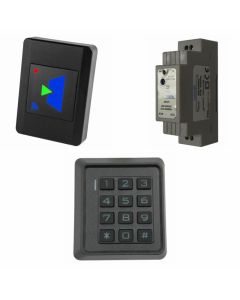We use cookies to make your experience better. To comply with the new e-Privacy directive, we need to ask for your consent to set the cookies. Learn more.
Near Field Communication (NFC): A Game-Changer for Door Entry and Security


How Near Field Communication (NFC) has changed key industries - one tap at a time.
From finding your way around a new city to frictionless payments, you use wireless technology every day - but think short-range.
GPS, Bluetooth, and Wi-Fi are familiar names; however, enter the unsung hero: Near Field Communication (NFC). NFC is a wireless technology that enables communication between devices in close proximity. It has been adapted to the door entry industry and has revolutionised security and access control.

A communication tower as imagined by generative AI. Cell towers, also known as base transceiver stations, facilitate wireless data transfer via internet connectivity and communication between IoT devices.
“The short-range nature of NFC technology makes it ideal for use in security-sensitive applications where ensuring proximity is valuable,” says the Competition and Markets Authority in its 2022 Mobile Ecosystems Market report.
According to researchers, NFC operates at 13.56 megahertz, with a maximum data transfer rate of 424 kilobits per second. NFC involves a communication exchange between two devices: an initiator and a target. The initiator, acting as the active device, initiates the data transfer process. The target device then passively or actively responds to the initiator's requests, completing the transaction.
Despite its modern appearance, NFC technology is rooted in the previous century, evolving from Radio Frequency Identification (RFID) concepts that gained practical application between the 1970s and 1980s. NFC can be used with devices that form part of the Internet of Things (IoT), which refers to a network of physical objects embedded with technology that enables them to connect, collect, and exchange data. NFC initially found its footing in the payment industry with contactless cards. However, its versatility has led to widespread adoption in various sectors. Today, this technology is ubiquitous in smartphones, smartwatches, and other devices, facilitating tasks such as mobile payments, data sharing, and device pairing.
It's best to not use the terms 'NFC' and 'RFID' interchangeably, although NFC is often classified as a type of RFID technology. As NFC operates at a frequency of 13.56 megahertz, its read range is limited to a few centimetres. In contrast, RFID systems utilise a broad frequency spectrum to accommodate various read ranges and data rates, including lower frequencies like 125 kilohertz -enabling longer read ranges of up to 10 centimetres.
"MIFARE Classic and MIFARE DESFire are popular high frequency technologies. MIFARE is secure as it has a higher encryption," says our Production Manager, Konrad Samczyk. Our DC300 works with MIFARE 1K tags, and is an excellent short-range access control solution, operating at 13.56 megahertz.
The SRS DC300 standalone access control keypad, RFID and fingerprint reader with app control.
Due to its high frequency and shorter read range, NFC is ideal for applications requiring close proximity, such as cloud and physical access control. By embedding NFC chips into access cards, key fobs, or even smartphones, businesses can implement robust and convenient access control systems. Employees or authorised personnel can simply tap their NFC-enabled device on a reader to gain entry to buildings, restricted areas, or specific rooms. This eliminates the need for physical keys, reducing the risk of lost or stolen keys, and ultimately, unauthorised access.
NFC is also frequently contrasted with Bluetooth, a different wireless technology. Bluetooth offers a longer range for connecting various devices like headphones or speakers, but it generally consumes more power and requires pairing. Alternatively, NFC's short-range capabilities make it well-suited for secure, quick data exchanges like contactless payments and access control. It's also energy-efficient and requires minimal setup.
NFC technology is useful in access management as users can easily update or revoke access permissions through software, eliminating the need for physical card replacement. NFC can effortlessly integrate with other security systems, such as surveillance and alarm systems, for a comprehensive security solution. Advanced systems can use biometric authentication, such as fingerprint recognition, in conjunction with NFC for enhanced security.
NFC technology has not yet achieved widespread adoption in global access control due to cheaper alternatives. "How the technology is implemented is cost-related. This is why NFC is usually used in high security situations," explains our production manager.
However, as technology continues to progress, NFC is likely to play a more seminal role in access control in the coming years. For instance, mobile credentials, whereby smartphones act as access keys, are gaining popularity. This trend simplifies access management and also enhances the user experience.
NFC has undeniably revolutionised door entry and access control in the 21st century. Its combination of short-range security and user convenience has made it a cornerstone of modern premises protection. As our world becomes increasingly interconnected, NFC's potential to continue to transform door entry and access control is immense.
At Door Entry Direct, we have over 10,000 products in stock. We're committed to providing the most innovative solutions to keep your installations at the forefront. Experience the future of door entry with Comelit Logos monitors, offering NFC and app-based function programming. We also stock the Aiphone GT-DMB-N video entrance station, which provides hassle-free tenant directory updates using NFC technology. Discover a selection of NFC and RFID-enabled products to enhance your door entry and access control projects by browsing our offerings below.
Follow us on social media for exclusive product updates, promotions, and industry news.
References:
Anusha, R., Krishnan, G., Unni, H. and Rao, S., 2015. Near Field Communication (NFC) Technology: A Survey. International Journal on Cybernetics & Informatics, 4, pp.133-144.
Coskun, V., Ok, K. and Ozdenizci, B., 2011. Near Field Communication (NFC): From Theory to Practice. West Sussex: John Wiley & Sons Ltd.
Kisi, 2024. A guide to RFID and NFC access control systems. Available at: https://www.getkisi.com/guides/rfid-access-control. [Accessed 19 August 2024].
O'Farrell, P., 2018. 5 Wireless Technologies In Your Pocket. Available at: https://www.forbes.com/sites/riverbed/2018/05/14/5-wireless-technologies-in-your-pocket/ [Accessed 07 August 2024].
The Competition and Markets Authority, 2022. Mobile Ecosystems: Market Study Final Report. London: Crown Copyright.

















